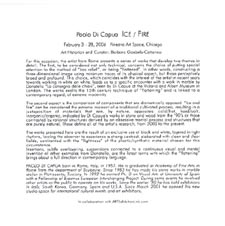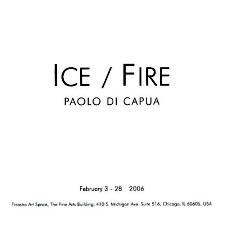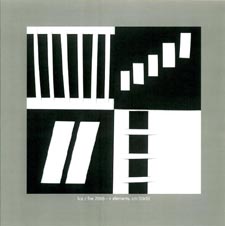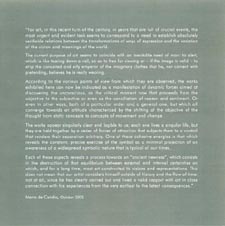


| Paolo di Capua Ice / Fire | ||||
 | ||||
 |
 |
 |
||
 |
||||
 | ||||
 | ||||
 | ||||
 |
 |
 |
||
 |
||||
 | ||||
 | ||||
 | ||||
|
Press Release
Ice and Fire - paradoxical principles, obviously excluding each other and yet longing for conciliation. In his series of reliefs executed in a plastic/synthetic material Paolo di Capua is concerned to visualize the intense contrast of contradictory principles juxtaposing them in geometrical compositions. He reduces the color palette to a minimum, to black, white and, rarely a shade of grey and creates an ultimate tension between light and darkness, black and white.
Black and white, the contrast: A common method to tame the frightening extremes is to insert them in a system of continuously alternating fields of black and white like the mosaic pavement (recalling the floor of Solomon's Temple mentioned in the Old Testament) and thus take comfort in the knowledge that the work turns with reliable recurrence. The contradictoriness is so softened or entirely dissolved as in Chinese philosophy, where opposites form an entity, black and white, Yin and Yang, are inseparably woven together in insoluble interdependency. In Paolo Di Capua's reliefs, the contrast of non-colors and the resulting tension is mitigated by his carving technique. He generally chooses wood as basic material for his artwork. The natural material forms a contrast to the rational system of geometry, the square and the triangle he focuses on. In the series exhibited here the artist is choosing for the first time a plastic/synthetic material for his 'carving'. Technically Paolo Di Capua refers to artists of the Italian Renaissance, especially the Florentine sculptor Donatello, who applied the highly refined 'schiacciato' in most of his reliefs. The 'schiacciato' (flattened out or low relief) involved extremely shallow carving creating a striking effect of atmospheric space, the sculptor no longer modeled his shapes in the usual way but rather seemed to 'paint' them with the chisel. Some of Paolo Di Capua's 'schiacciato'-reliefs remind textile netting with warp and weft thread, passing under and above one another and thus integrating black and white in a 'tapestry' forming a completeness of all aspects of life, the light and the dark. Paolo Di Capua's complex artwork reveals a passionate individual quest, a research between striking contrasts and precautious attempts to conciliate them in a dialectical way, a quest, that occupied mankind throughout the past and will preserve it's relevance in the future.
ArtExhibitionLink
|
||||
 | ||||
 | ||||
 | ||||
| View the Work | ||||
 | ||||


